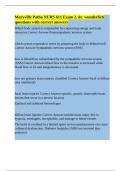Maryville Patho NURS 611 Exam 2. dr. wunderlich
questions with correct answers
Which body system is responsible for conserving energy and body
resources Correct Answer-Parasympathetic nervous system
which system responds to stress by preparing the body to defend itself
Correct Answer-Sympathetic nervous system (SNS)
how is blood flow redistributed by the sympathetic nervous system
(SNS) Correct Answer-blood flow to the muscles is increased while
blood flow to GI and integumentary is decreased
how are primary brain injuries classified Correct Answer-focal or diffuse
(aka multifocal)
focal brain injuries Correct Answer-specific, grossly observable brain
lesions that occur in a precise location
Epidural and subdural hemorrhages
diffuse brain injuries Correct Answer-include brain injury due to
hypoxia, meningitis, encephalitis, and damage to blood vessels
The brain is confined in a limited space so increased pressure can cause
collateral dysfunction: Diabetes Insipidus (ADH not secreted thus
polyuria)
,autonomic hyperreflexia Correct Answer-affected at the t5-t6 level or
above; characterized by paroxysmal HTN (up to 300 mmHg systolic), a
pounding headache, blurred vision, sweating above the level of the
lesion with flushing of the skin, nasal congestion, nausea, piloerection
caused by pilomotor spasm, and bradycardia (30-40 beats/min)
location of lesions in cases of autonomic hyperreflexia Correct Answer-
individual most likely to be affected have lesions at the T5-T6 level or
above
sequence of events that lead to hyperreflexia induced bradycardia
Correct Answer-bradycardia (30-40bpm) is a sx of hyperreflexia
Stimulation of the carotid sinus -->vagus nerve -->sinoatrial (SA) node.
The intact ANS reflexively responds with an arteriolar spasm that
increases blood pressure. Baroreceptors in the cerebral vessels, the
carotid sinus, and the aorta sense the HTN and stimulate the PNS. The
heart rate decreases, but the visceral and peripheral vessels do not dilate
because efferent impulses cannot pass through the cord
Alzheimer's disease Correct Answer-leading cause of dementia and one
of the most common causes of severe cognitive dysfunction in older
adults
what are the greatest risk factors for Alzheimer's disease Correct
Answer-age, family history
, what are the proposed protective factors for Alzheimer's disease Correct
Answer-low calorie diets, estrogen replacement at time of menopause,
NSAIDs, physical activity, antioxidants, the presence of apoE2
what genetic susceptibility tests are used to screen for early-onset AD
Correct Answer-PSEN 1 (presenilin) on chromosome 14, PSEN 2, and
APP (amyloid precursor protein) on chromosome 21
When can a specific diagnosis of AD be given Correct Answer-
postmortem examination
what is the single greatest risk factor for stroke Correct Answer-
hypertension (87% of occurrences)
what are common risk factors for stroke Correct Answer-arterial HTN,
insulin resistance and DM, elevated cholesterol or low high density
lipoprotein (HDL), elevated lipoprotein- A level,
hyperhomocysteinemia, congestive heart disease and PVD,
asymptomatic carotid stenosis, polycythemia and thrombocythemia, a-
fib, postmenopausal hormone therapy, high sodium intake above
2300mg, low potassium intake less than 4700mg, smoking, lack of
physical activity, obesity, chronic sleep deprivation
which autoimmune disease typically presents 2-4 weeks following a
bacterial/viral infection such as respiratory or GI illness (ex: flu) Correct
Answer-Guillain-Barre syndrome




